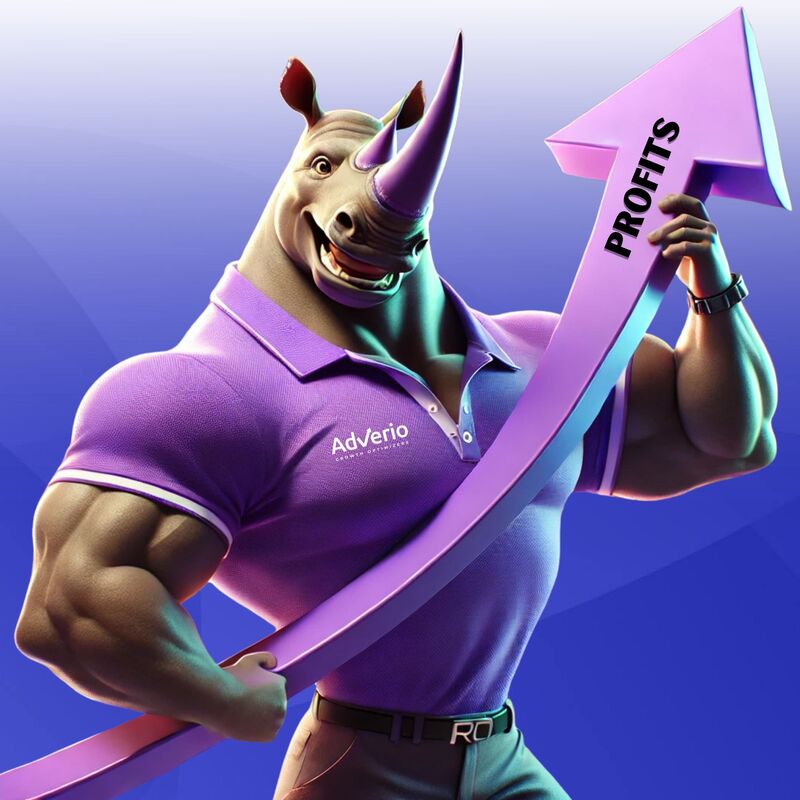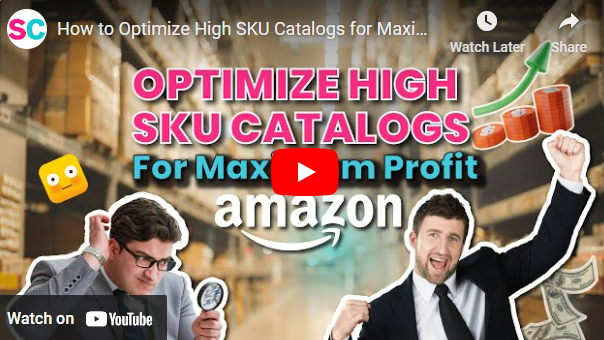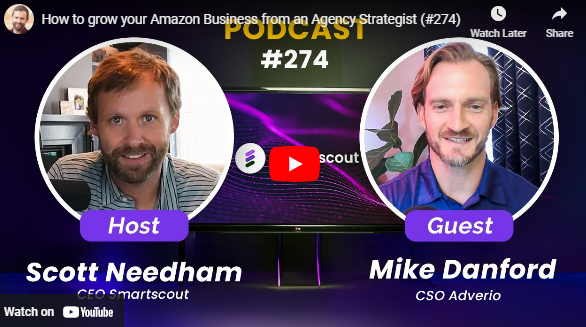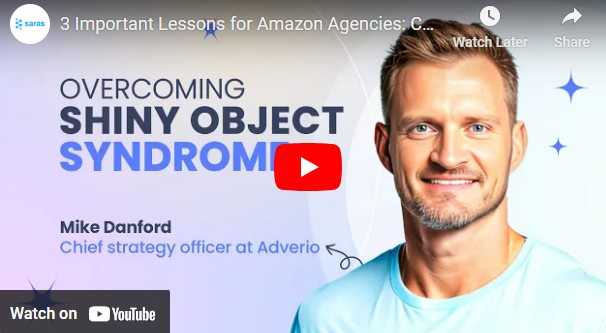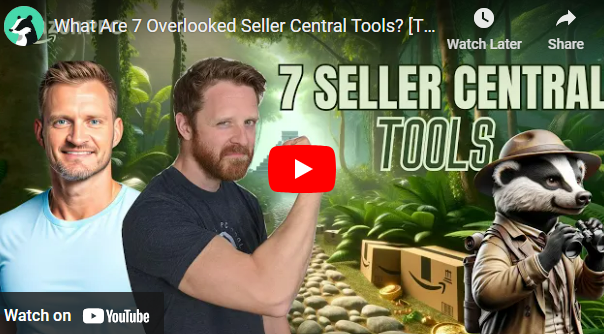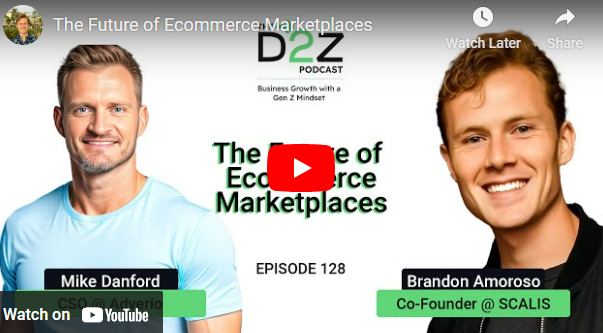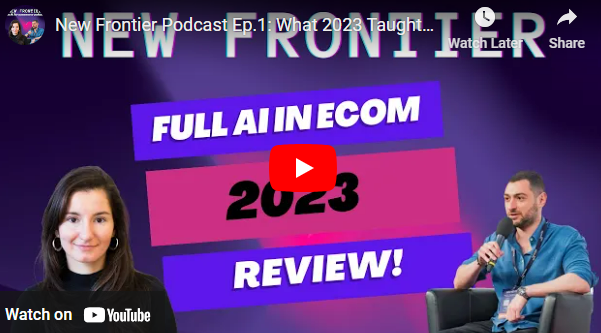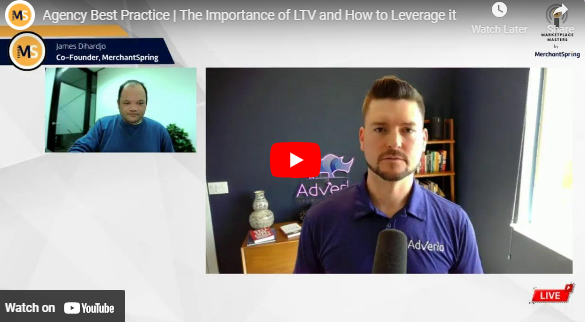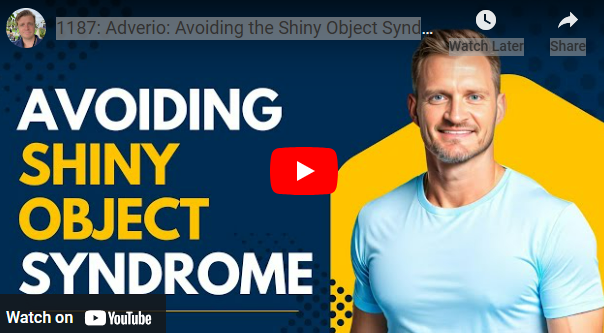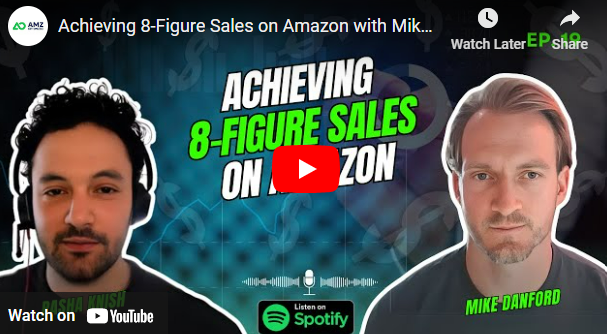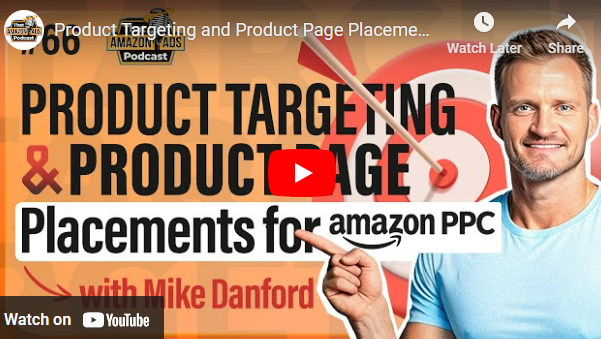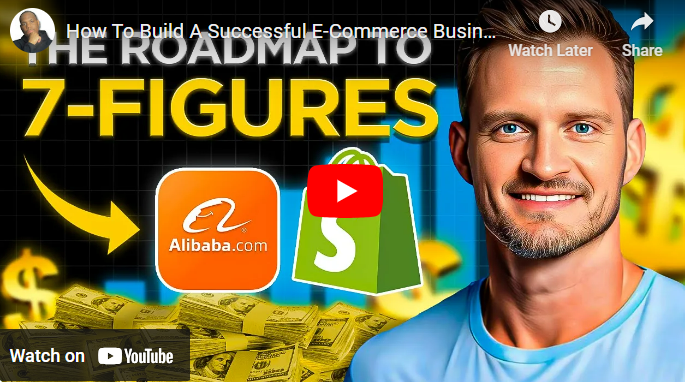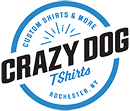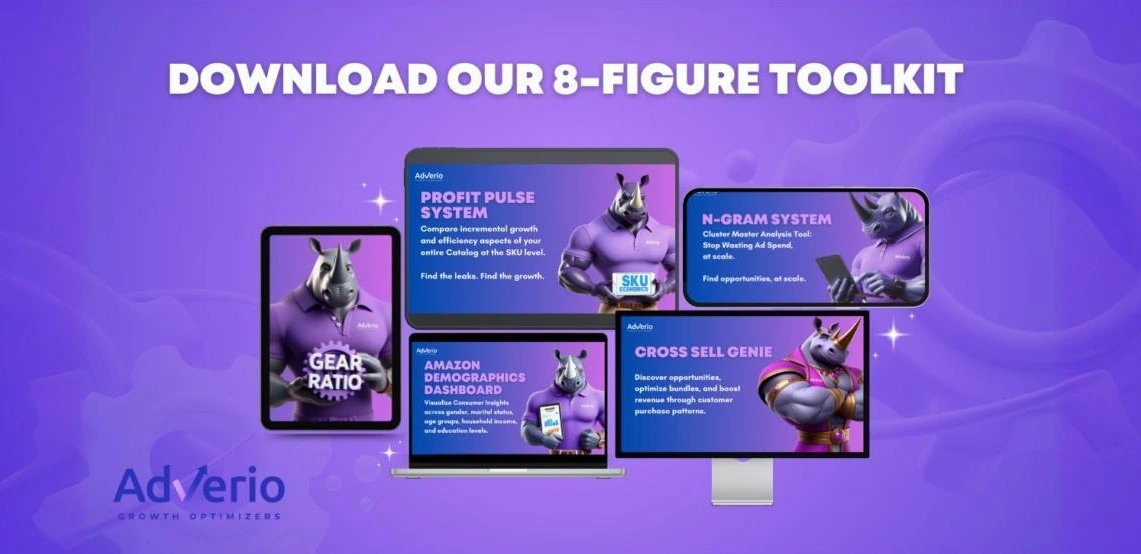Smartest Amazon Seller Podcast
Work Smarter, Not Harder.
Join Scott Needfham and Mike Danford, CSO of Adverio.io, as they dive into game-changing strategies for Amazon sellers. From understanding why many brands face stagnation to exploring dynamic pricing, SEO, and conversion rate optimization, this podcast covers it all. Learn how to leverage tools like Seller Central Utilities and machine learning for predictive analytics to boost your sales performance. Danfords journey from selling supplements to mastering large catalog management offers invaluable insights for anyone looking to elevate their selling game on Amazon.
- 00:03 Strategies to grow stagnant Amazon business
- 02:32 Started with a health supplement for dad’s arthritis and joints.
- 06:30 Optimizing sales for brands with large catalogs on Amazon
- 08:41 Leveraging machine learning and predictive analytics for proactive marketing.
- 12:50 Private label Brands are focusing on pricing and automation.
- 15:10 Dynamic pricing strategies impact profitability
- 19:01 Utilizing search query performance for business growth
- 20:40 Understand data points for pricing and positioning.
- 24:16 Utilizing Amazon data for business growth
- 26:04 Closing thoughts and gratitude
- Crafted by Merlin AI.
Mike Danford: [00:00:00] Most brands will come to us and they’ve been selling on Amazon for five, 10, 15 years, and they’re, they’re either flat, stagnant, or, maybe not growing at the rate that they want to, or maybe even losing some market share in there. They’re trying to figure out new ways, or to know which products to push and pull, or which new products to go after, etc.
And, a lot of brands just haven’t done the basics, or they’re like pre COVID, they still haven’t tried the new things that are different since COVID hit. Or how it’s changed a lot of stuff. One, two, three. Welcome
Scott Needham: to the smartest Amazon seller podcast. I am your host, Scott Needham and the goal of this show, this podcast, I’ve been doing this for five years.
And it’s still the same where we just want you to be a little bit smarter about the opportunity of selling on Amazon. There’s a lot of different ways to succeed and but [00:01:00] it’s just a huge marketplace. And I find that if you keep your mind open, there’s always something that you can do. If you’re an active seller or you want to sell, or you’re a brand that like is.
Wondering how does this Amazon thing work? Just keep your mind open because there’s always new angles specializations that people are like Tackling it and I have a guest who has seen the variety of ways to sell and to work around amazon I have mike danford founder of adverio and he, what he he’s done one of the things that I love the most.
And when I talk to someone, bring them on the podcast, he’s transitioned. He’s seen the multiple different ways of operating on Amazon. And we’ll jump into it. Mike, welcome.
Mike Danford: Thanks for having me, Scott. Looking forward to it.
Scott Needham: Oh, all so yeah, let’s just hear your story. You started out as just an Amazon seller and And in a [00:02:00] variety of ways and, learn some things the hard way, I presume.
And yeah, just listen, give us your background.
Mike Danford: Yeah, absolutely. So back 2014 found what was ASM American or Amazon selling machine or whatever it’s called. Got into it. And started, looking into building my own supplement. That was a health supplement for my dad’s arthritis and joints. And that was great, a little slower than I wanted to be in the beginning.
And then, it was all about going and doing retail arbitrage or online arbitrage at the time I was living in Charlotte and had access to a bunch.
Scott Needham: So you started a supplement and you’re arbitraging, which would happen first,
Mike Danford: started with the supplement and then trying to bridge the gap. I started doing the retail because I already had the account.
Scott Needham: Yeah. Was that bridge the gap more to be like, Hey, I want to be a full time Amazon seller and I just need to do this.
Mike Danford: Yeah, it was more about trying everything. I gave myself, six [00:03:00] to eight months to see what, what would work and want to know how to do it. And then a buddy of mine came up from Florida.
He was traveling all over Florida buying thousands and thousands of Nikes every weekend was, he came up here and showed me how I did it and I started doing it. Okay. So that was like a happenstance, you
Scott Needham: know? Were you mainly in shoes? Did you follow that same, style?
Mike Danford: Shoes are easier just the way with the packaging quicker.
The software that we were using was much easier. You could get into some of the apparel, but she was just much easier to move. You could really understand the demand and what would sell.
Scott Needham: And once you jump into apparel. It’s a bigger beast, larger catalogs, who knows what actually, customers want, but I can always tell you they’re going to want the latest version of of Nike’s running shoes.
That’s always in demand. And we’ll then take us I always like to find where people started you’re part of the the Amazon selling machine, that’s part of your pedigree, so to speak. [00:04:00] I’ve got one that’s similar where This person got into it, then this person got into it.
Then educated my brother, then like this. So there’s some dominoes that everyone has that brings them into it. But what are the next stages? Did this a supplement brand, evolve?
Mike Danford: Yeah, it was, it worked out really well. Again, my dad was able to use it when we were doing our trials and everything, and it really actually worked well for him.
I had a little bit of arthritis or onset was coming on, so it was great. And, What I learned there is, we’re using a pretty common formulation at the time, and it was all about who could out market whoever had this similar formulation, and I realized that it’s really hard to go against the Costco’s of the world on, or the Kirkland, if you will, on Amazon and some other stuff as well.
It’s plateaued in our revenue and it was like, hey, do you want to go to the next level? You got to bring out a bunch more products or invest as much capital or it’s going to be expensive. They take more market share. And then at the time when I was slinging the Nikes, I was like, this is just so much easier, selling black and white tennis shoes.
And it was just faster and easier [00:05:00] and quicker. And it was a manual process, which kept me engaged with it. And then I had someone that said, Hey, I want to add, that a joint supplement to their catalog. Would you willing to us to pick it up? And I was like, yeah, cause I didn’t want to make that next big investment at that time.
Cause I’m 23, 24 at the time trying to figure it out. And then just kept doing the Nike’s and as I was doing the average, I still did the advertising for the supplement after I sold the, or got rid of the brand or the product. And started posting some of those results through the Facebook groups and whatnot.
And they were the feedback was, Hey, this looks awesome, especially in the supplement space. Would you mind doing it for us? And then we pay. And then the history from there is just growing and starting to add space and now doing creatives and, full service management of the agency.
Scott Needham: Interesting. When, what you, what year was the, like when you got into PPC, or started doing that?
Mike Danford: Yeah. 2014, 2015 is where all this kind of all took off.
Scott Needham: Okay. Yeah. Cool. That’s 10 years from now. It’s [00:06:00] a lot has evolved and changed. You said one of the things that like, You’ve had success with some of your clients.
It’s something that I’ve seen as like a unique challenge and that’s large catalogs, you think of apparel, you think of maybe even auto repair, like just like lots of little pieces, lots of parts, lots of skews, and that starts to make your spreadsheets look bigger. How did tell me some of your experience with these large catalogs.
Mike Danford: Yeah. Most brands will come to us and they’ve been selling on Amazon for five, 10, 15 years. And they’re, they’re either flat stagnant or, Maybe not growing at the rate that they wanted to or maybe even losing some market share in there They’re trying to figure out new ways or to know which products to push and pull or which new products to go after Etc.
And you know a lot of brands just haven’t done the basics or they’re like pre covid They still haven’t tried the new things that are different since covid hit where obviously changed a lot of stuff And [00:07:00] we commonly have after the first three months or so of working with a new brand Hey this product hasn’t We haven’t sold this in years and you’re now it’s like our top 10.
How do you do that? And how we do that is different, there’s ways of looking at the SEO side conversion rate, optimization, et cetera. And then there’s obviously advertising. And then one of our, more recent levers and probably the last year or so that we started pulling this dynamic pricing to help us with that.
And it’s just, now, I had up our technical side and development side and we’re pretty good at being able to see from a sell side when a product is moving and has potential and pour more gas on that through our profit pull system. What I’m trying to work on now is understanding, the lift or changes in a click to rate and conversion rate before the traffic kind of catches up onto that.
So you can see if we can be a little more proactive. To those, losers and winners et cetera. So that’s fun for me now, getting into more of the machine learning and predictive analytics for sure.
Scott Needham: I guess what do you see with say a [00:08:00] catalog of say a dozen SKUs versus a catalog of a thousand SKUs and from the brand management perspective that you have what’s like the different initial approach if it’s 12, it’s it’s not that hard, whereas like it’s a thousand, you’re like, okay, if I’m rolling out advertising across all of these, and they have small differences from each other, maybe it’s different variations one piece of clothing can actually have 500 variants if you got size and color and all that.
Mike Danford: So for a smaller catalog, I feel like you’re really able to focus on the incrementality and minutia within a product, a lot more split testing, whether image, copy, et cetera, and really just going all in. And then I think if you’re faster to try to find external traffic and factors to these products in your, You’re just living and breathing those and then from there it’s, how can I bring other products in looking at market basket analysis?
Would it be commonly being [00:09:00] purchased with my products? Is it a different variation, different size? Combination? Is it a totally different product altogether? We find that all the time. Then with a larger catalog, we the faster way to increase revenue and profit is generally just going after the B and C tiers of the catalog, the ones that have been forgotten about, the ones that have Dust on my shelf or, Hey, my COGS has changed and I haven’t really pushed it.
It’s better now or things of that nature.
Scott Needham: I’ve heard sometimes on that with the B and C tier products are like on Amazon, it’s easier to turn a good product into a great product than a bad product. Into a good product. I’m sure like both of our framings each have like their, where it’s totally true, but tell me about these like C tier products that you’re like, Oh, just give them just a little bit of love and then things change.
Mike Danford: Yeah. So we have a C one and C two tier. And with that it’s usually the quickest lever. There’s two levers that we pull. It’s going to be [00:10:00] advertising kind of a low cost. They probably never advertise. Or they haven’t advertised in years, so they don’t really have any good data. And now, obviously, with the pay to play space, if it’s been three or four or five years since they’ve really pushed, it’s lost a lot of visibility and sometimes just getting it going with a little bit of traffic.
And there’s a process that we graduate through with a budget and really conservative, cheap clicks just to see what happens. 15, 20 percent of that will start to surface up, and then they can try to see if they can move it from the C2 to 1 and to B, and obviously A would be a long term strategy.
And that’s one. And the other is, it’s, let’s play around pricing. Let’s not really spend any money on it. Let’s just see if you can get some additional conversion, improvement or click through, et cetera, just by getting more competitive on pricing, et cetera. So those are fun to just play around with those and then to your point, I like that we haven’t heard of it or talked about it that way, but I would say it’s easier for us to get a B into the A, like you said, instead of a C into a B group, for sure.
It’s a lot of work if a product [00:11:00] really isn’t getting any traffic or activity as opposed to something that’s getting a little bit and it’s a good product. It just needs to be reframed. differently or put a little more, effort behind it for sure.
Scott Needham: You also mentioned dynamic pricing. That’s a new conversation.
There’s a few players. I’ll just name a few, but I, I’ve had conversations with both. We got Prophecy and actually Trellis. These are tools that are talking, I know there’s a few others, and so forgive me if I don’t get everyone that’s talked about repricing, but you’re seeing private label brands really think more about pricing and using automation more than ever.
What’s your experience with this piece and how has that affect like some of these brands that you work with?
Mike Danford: Absolutely. Again, working with larger catalogs, those platforms you mentioned, most of them, one of those two, as you mentioned, it’s [00:12:00] much easier for them to handle larger catalogs, a lot more products than the other.
So that’s great. It’s a spray and pay spray and pray approach where we can just go in and put some min maxes in and see what happens pretty quickly. For those and that’s been fun. And then the others are, going into the A group where, it’s already pretty well optimized listing you have pretty efficient, pretty effective and maxed out on your sponsored ads, maybe even getting the DSP as well.
And then within that group, you’ll also have something like top sellers in their category and it’s really not more real estate or market share available for that particular skew.
Scott Needham: Yeah.
Mike Danford: Now you’re trying to squeeze out more profit without
Scott Needham: I’ve got one experience where we had a product go viral on tech talk and like we had a lot of inventory, a lot, but it’s also happened to be Christmas.
So the thing is we were making like 15 percent gross margin, not like a ton. But I started playing around. It’s like increasing a dollar or two and it didn’t really impact sales. Actually. I [00:13:00] think I’ve been tested 5 or 10. Like I, I tried it all and it’s amazing how with these like A tier products that there’s actually more profit you can make, do you risk competition?
Sure. But that’s the, that’s the magic of something a little bit more dynamic is if you you’re able to optimize for a specific goal where you could change that goal. Within a week, two weeks, it’ll be like, okay, let’s make profit. And then later you’re like, no, let’s sell the units.
Let’s be the winner. I guess what I’m saying is from our perspective, even changing the price by 1 for 24 hours made a margin, made it made an impact on that day’s gross margin, like that day’s profitability. And there’s just very, when it comes to dynamic pricing, the B tier guys, like you could do some stuff with pricing and the A tier guys, you could do different stuff with pricing and both of it matters, it’s both like [00:14:00] meaningful.
Mike Danford: Absolutely. Tons of different strategies, around tent pole events, trying to squeeze out more juice or preserve inventory if you’re going low or you got a late shipment coming in. And then there’s, trying to show what charm pricing, if they are, if they have charm pricing Hey, let’s add those few cents back to it.
I’ve
Scott Needham: never heard the term charm pricing.
Mike Danford: Yeah. So charm pricing is where you want to end at a nine point nine six as opposed to a point nine nine or yeah, they got these special things or whatnot. So getting those few pennies back, we sell a lot of apparel sets, millions of units a year.
Millions of pennies adds up, over time, right? And then, just playing around with that and the small incremental changes again, like to your point, there’s so many different ways of doing it and then do like anchor pricing where you’re playing around with individual variants and colors to see how you can get them to convert better or anchor your price better to make them, there’s so many different ways of doing it.
And that’s where I love the machine. I’ve been able to help us do that and look at the demand elasticity versus the profit elasticity as well. Yeah.
Scott Needham: Yeah [00:15:00] Mike, I was looking through our email history, preparing for this. And I came across one that I was like, Oh, wow, this is full circle where I, on my newsletter gave a shout out for a new little tool a new Chrome extension that it’s called seller central utilities.
And I think, you got wind of it and you started an email conversation with like with URI, the founder and. And I’m excited cause I’ve heard great things about it, but you’re the first that, it seems like, you glow up when you you talk, you hear about it.
So tell us a little bit more about the seller central utilities, how you use it, where you think like some of its biggest benefits are
Mike Danford: sure. Yeah, you’re is great. We, at first it was talking about search query performance. And digging that and how do we automate like through a robotic process automation rpa pulling the data at a product level or An account level we have some different accounts, etc So they built that and then release the [00:16:00] Where when you’re inside a campaign manager, you have a separate chart that gets pushed above your campaign manager chart and it will show you your tacos ppc conversion ad conversion and percent of ad sales You obviously this is not inclusive of any DSP advertising dollars, but it makes it where when you’re inside the campaign managers, you can just quickly see how you’re, you’re, somewhat of your profitability based on tacos and then see how the ads are converting versus excellent.
I love the way it’s interesting
Scott Needham: that like. He’s built two free solutions that are very different. One is very like the search query performance, like some of the data, be able to get that into Excel over time in a way, and then he’s Oh, and by the way, I’m creating these charts. They’re a little bit better than Amazon.
They have a few more data points. I actually have one question. So the search query performance, what’s the main value on that, that his tool provides that you don’t get? [00:17:00]
Mike Danford: Admittedly, we don’t use it. We build our own RPA process that goes directly into our dashboard. But it’s a very similar concept that he has.
But we, you could do it at the ASIN level and we do that. Sometimes we’re trying to go back on a few products. But for us, we built a role on top of it. So it was cool.
Scott Needham: We’ll tell us about like the history, like what kind of insights do you get from a history of the, that report of the search query
Mike Danford: for us right now, we have a lot of brands that have more than your normal tent poles.
So we’ll have a lot around the U S holidays, father’s day, mother’s day, et cetera. And it’s going back and looking at the data. One, what was your share over time? What were some other terms you may not have missed or didn’t catch at that time? And also you’ll see some stuff bubble up as we get near those tentpole events that may or may not be on your radar and the type of semantics are a little different.
That’s pretty exciting as well. And then it’s just good to, going back to a smaller brand, we can pretty much get a good idea of what your TAM is just inside of that. And at least your search TAM, if you [00:18:00] will. We can do that for your brand as well and say, Hey, your search, the ownership of your search across all of your products, cause you’re limited to.
If you do the comprehensive report, I want to say it’s 2, 500 or 3, 500 rows. It is changed a little bit. And that just shows you how you’re doing when you’re searching what Amazon thinks you’re doing well, love over time. So that’s pretty cool for us to understand where to push and pull.
Now obviously you can get into, there’s ways that are perverse, like your, what’s your CTR versus the competition, what’s your conversion rate. And then you can get an idea of your pricing as well at the product level, but really at the search term level, if there’s a lot of traffic and the top sellers have, a lower price than you or a higher price than you, then it gives you an idea of what to and what not to push and how to position yourself as well.
That pulls unique insights. Thanks guys. The list goes on as they continue to release the data and improve the data.
Scott Needham: Yeah. You guys have also built your own set of tools, but we’re thinking like spreadsheets, visualizations Tell us about more of that development and why and how people can use them.
[00:19:00]Mike Danford: Yeah, absolutely. So typically we, we have two different teams. We have a data science team that works in the Google suite and makes light nimble reports. Anytime a new brand comes in, we’re trying to find something unique for them or build it or a play boss or sandbox is a little easier for us.
And then we have another. Team that we work with that does more of our, full, BI and reporting intelligence, etc. So we take these concepts and we build them and play around with them and then we give them to the other team. And once we build them they’re useful for us. And then we give just, let other folks have it.
A lot of times it’s how to manipulate and visualize the data that Amazon’s giving us. It’s a lot of data. How do you call it? How do you put it together? And then what’s the best way to visualize it. And then now we’re starting to bolt in some machine learning into that as well, and helping you know how to set it up and how to data mine it through GPT once it’s presented a bunch of other things.
So it’s my projects. We have a full time data scientist that works with me every single day, every single week. What’s new, what can we do? What’s Amazon releasing? We see a report. We like, Hey, can we reverse [00:20:00] engineer that? Can we improve that? Can we do it for the rest of our brands, et cetera.
So it’s fun.
Scott Needham: Awesome. And you guys are just, you’re giving some of those out, right? Yeah,
Mike Danford: absolutely.
Scott Needham: So that’s on your, so that’s on your homepage. If people want to, want more tools free ones. I actually really spreadsheets because I know they’re easy to configure, they’re easy to understand, like what’s going on.
And that’s on your website at Vario, right? How do you spell that?
Mike Danford: A D V E R I O dot I O. How’d
Scott Needham: you get that name?
Mike Danford: I don’t honestly know. I wasn’t a part of that process. I didn’t have an ads in it. I’m not, I wasn’t.
Scott Needham: You’re like, Oh, good enough. I’ll run with it.
Mike Danford: Yeah. Yeah. I was involved with the V like, up into the right.
And then you can’t see where there’s a rhino over here. So we have a mascot that’s a rhino as well. It’s a lot of stuff with that right now for our social content and some other things we’ve personified a rhino. So it’s fun.
Scott Needham: Nice. [00:21:00] How’s, how do you feel about, this post COVID, what are some predictions or like comments like where’s Amazon going?
Mike Danford: Yeah, that’s a, that’s an interesting question. I to take a little bit of a page out of Bezos book where he talks about Hey, let’s focus on what’s not going to change for the next 10 years. And let’s build around that as opposed to having the shiny objects syndrome. Obviously keeping a pulse on that.
So I try to do that myself. It’s just trying to figure out how to pull more levers. Amazon is starting to give us more data than they’ve ever given us, which is awesome, but there’s limitations to that. And then it’s how valuable is it? It’s let’s take a look at this data, understand do we need to focus on it and then how can we do it at scale and how can we improve it and enrich it for ourselves and for our brands that we work with.
Obviously right now we’re pretty big in the space on the AI side in terms of mining, textual data, as well as now getting more into the images and videos and playing around with Amazon recognition, Cosmo Rufus, all of those. And I think that’s where it’s going. It’s [00:22:00] way more conversational and a lot more NLP or neuro linguistic programming involved as well.
And what am I going to use this product for? So your lifestyle images and need to be more. Outside of just the search terms. Because when you go in now with Rufus, you’re asking some questions. I need this for, I need this dress for our shirt for Paulo, whatever, for this event, and I’m going here, what’s the best one.
And it goes to ask a few questions and then it gives you a search term.
Scott Needham: I didn’t know that. Does it, Rufus will ask you follow up questions?
Mike Danford: Yeah, you can depends on how you communicate with you guys. You can literally ask it pretty much anything pretty interesting to play around with it. But you want to get it more like use cases, etc And it’ll guide you as well It’s pretty fun
Scott Needham: That’s cool.
Awesome. Mike, thank you for giving him some of your time. Love hearing some of the transitions that you made as a thing that gives people a lot of perspective. I’ve made multiple transitions [00:23:00] and it’s always exciting, but thanks for coming on the podcast.
Mike Danford: Yeah, Scott. Thanks for having me.
Scott Needham: Okay. We’ll wrap up there. Thanks everyone for listening and stay tuned for our next podcast and we will catch you then. Take care.

